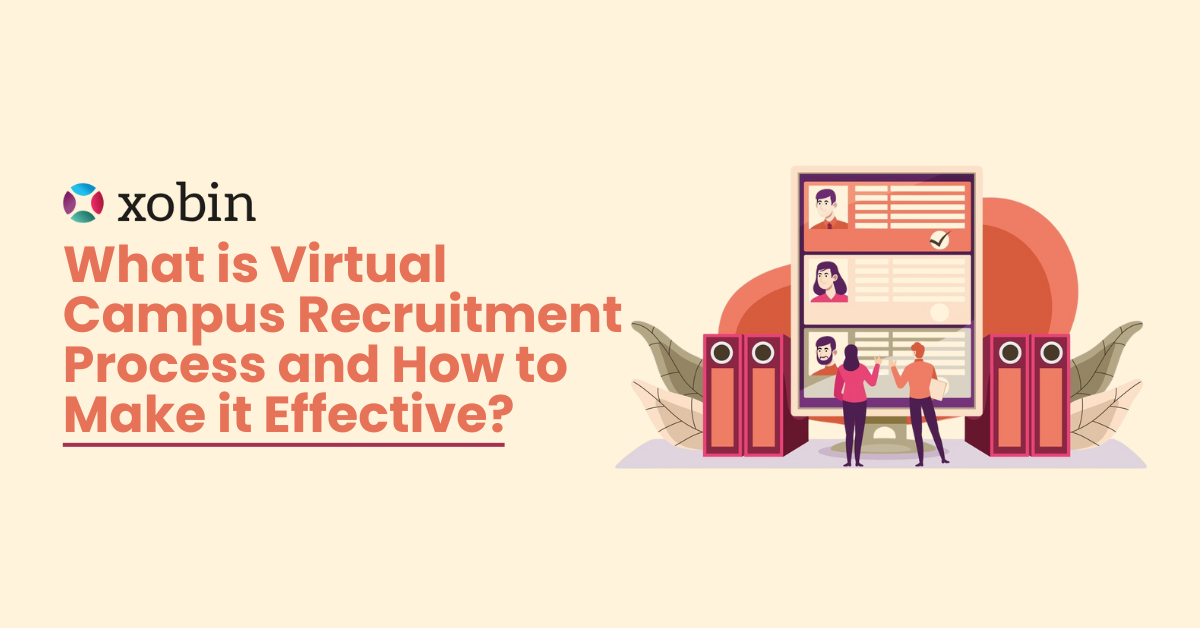As competition intensifies to secure top-tier talent, recruiters are constantly seeking efficient strategies to connect with high-potential candidates. One of the most impactful ways to do so is through the campus placement drive, where recruiters engage directly with students on college campuses to find the best-fit talent. From reviewing resumes and conducting interviews to managing candidate pipelines, every part of the virtual campus recruitment process demands attention, precision, and strategic planning.
Table of Contents
What is Virtual Campus Recruitment Process?
The virtual campus recruitment process refers to the use of online platforms and tools to conduct recruitment activities. Instead of visiting colleges physically, recruiters assess, interview, and hire students remotely. This method has gained significant traction, with 90% of companies shifting to digital recruitment strategies post-pandemic. Virtual recruitment allows employers to access a global talent pool, increasing the diversity of candidates. Moreover, candidates prefer online assessments, because of convenience as a major advantage. By utilizing virtual recruitment, companies can streamline their hiring process, ensuring a more efficient and cost-effective approach to talent acquisition.
How to Make Virtual Campus Recruitment Process Efficient?
Stage 1: Planning and Strategy Development
The first step in the virtual campus recruitment process is strategic planning. A well-organized recruitment plan lays the foundation for attracting the right talent and ensuring the process runs smoothly.
- Define Your Recruitment Goals: What skills or qualities are you seeking in candidates? Whether it’s technical expertise or soft skills, setting clear expectations will help guide your recruitment strategy.
- Identify the Right Campuses: Instead of spending hours researching, Xobin compiled a list of the best colleges for campus recruitment. This curated list helps you target colleges that align with their hiring needs, ensuring you connect with high-quality candidates efficiently.
- Allocate Resources and Budget: Consider the logistics and financial aspects of your campus recruitment drive. From travel to promotional materials and campus engagement activities, proper resource allocation ensures smooth execution.
To manage the recruitment process effectively, Applicant Tracking Systems can play a crucial role in organizing job applications, tracking candidate progress, and automating tasks that can be time-consuming when done manually. An ATS can streamline the workflow by keeping everything organized and accessible.
Stage 2: Building Relationships with Campuses
After your strategy is in place, the next step is to foster relationships with campus placement cells, student organizations, and other relevant stakeholders. These relationships will help ensure that your recruitment efforts are well-supported.
- Collaborate with Placement Offices: Engaging with campus placement officers helps you stay informed about recruitment timelines, available talent, and logistical details. They can be a valuable partner in ensuring your presence at the right events and engaging with students.
- Host Pre-Placement Talks and Workshops: Conducting webinars gives students a deeper understanding of your organization and the roles you’re offering. This helps create awareness and boosts engagement.
- Offer Internships or Live Projects: Offering internships or live projects allows you to evaluate potential hires in a real-world context. This also gives students a chance to experience your company’s culture and gain valuable skills.
To simplify application collection and make it more engaging, you can use a video-first job application management system. This tool allows candidates to submit video responses to key questions, giving you a better sense of their communication skills and personality before even meeting them in person.
Stage 3: Application and Screening Process
The application and screening phase is where most of the heavy lifting happens. It’s crucial to develop a system that can efficiently handle large volumes of applications while ensuring that only the most qualified candidates move forward.
- Streamline the Application Process: A centralized application system ensures that all candidate data is stored in one place. As a result, it makes it easier to access and track candidates.
- Set Clear Screening Criteria: Establish clear criteria for evaluating candidates that align with your company’s values.
- Automate Screening with Assessments: Pre-employment skills testing allows recruiters to screen candidates efficiently on the basis of skills and qualifications. This helps in reducing the time spent on initial sorting.
- Automated Screening with AI: AI-powered answer evaluation systems analyze test responses of candidates. It ranks applicants based on performance, and filters out the best matches for the role.
- AI-Based Web Proctoring: To maintain test integrity, eye-gazer tracking, browser monitoring, and advanced web proctoring prevent cheating in online assessments.
By integrating skills-based assessments, you can assess both technical and non-technical abilities in one go. This helps in identifying top candidates who meet your specific requirements. Moreover, psychometric testing is an invaluable tool in understanding a candidate’s cognitive abilities and personality traits. It helps recruiters gain deeper insights into how candidates might perform in various work situations, assisting in making more informed decisions.
Additionally, online testing and assessment provide an opportunity to standardize the hiring process. All candidates, regardless of their background, are tested in the same way, ensuring a level playing field where decisions are based on merit.
Stage 4: Interviews and Candidate Evaluation
Once you’ve shortlisted candidates, the next step is conducting interviews and evaluating their qualifications, skills, and cultural fit. This step is crucial in determining whether a candidate will succeed in your organization.
- Structured Interview Process: Using a structured interview format ensures that evaluating candidates on the same criteria makes it easier to compare responses for objective decisions.
- Evaluate Soft Skills: Technical expertise is important, but soft skills such as communication, problem-solving, and teamwork are just as critical in assessing overall fit. These skills help candidates adapt and thrive within your organizational culture.
- Use Virtual Interviews: Campus recruitment often involves candidates from different geographic locations. By conducting video interviews, you can engage with candidates more flexibly and save time compared to in-person meetings.
Automated video interviews make this process more efficient by allowing you to conduct interviews at any time, on-demand. You can also evaluate a candidate’s communication skills through an AI-powered English communication checker tool that analyzes their speech, tone, and clarity, helping you assess their overall ability to convey ideas effectively.
In addition, real-time coding skill assessments are essential for tech recruitment. Candidates can be tested in simulated environments that assess their problem-solving skills and coding abilities, giving you a more accurate picture of their technical proficiency.
Stage 5: Offer, Onboarding, and Follow-Up
The final stage in the virtual campus recruitment process involves extending offers and managing the onboarding process. This is where you officially welcome new talent to your organization and ensure they have everything they need to succeed.
- Offer Letter and Negotiations: Once you’ve selected your candidates, it’s time to extend an offer. Ensure that the offer process is streamlined and that candidates have a clear understanding of the terms.
- Onboarding: This is a crucial phase, as a well-organized onboarding process ensures that new hires feel welcome and ready to contribute to the organization. Therefore, plan for induction programs, training schedules, and the integration of new employees into the company culture.
- Follow-Up: After candidates have joined the organization, continue to follow up with them to ensure they are settling in well. This also helps in collecting feedback that can improve future virtual campus recruitment processes.
Actionable reports can provide deep insights into candidate performance throughout the recruitment process, allowing you to evaluate the effectiveness of your selection criteria. By using data-driven reports, you can continually improve your hiring strategy to match future recruitment efforts better.
Moreover, AI-based recruitment automation tools help streamline the entire process, from initial candidate sourcing to final offer generation, making your recruitment process not only efficient but also more accurate.
Why Recruiters Need a Campus Hiring Platform Like Xobin?
A campus recruiter’s day is long, full of responsibility, and involves intricate planning and coordination. However, the online campus placement drive can be automated using Xobin’s AI-powered campus recruitment software.
Our comprehensive platform helps recruiters streamline every part of the virtual campus hiring process, from job posting to candidate screening and final offer rollout. By automating much of the administrative burden and integrating with assessment tools, Xobin saves recruiters valuable time, allowing them to focus on what truly matters – hiring the best talent!
Here are a few features that can significantly enhance your virtual campus recruitment process:
- Automated Job Posting: Easily post and manage job openings across multiple platforms.
- Automated Screening: Automatically filter resumes and assess candidates based on skills, experience, and job-fit criteria.
- Pre-build customizable Tests: Assess candidates using a vast skill inventory of 3400+ skills tests and 2400+ job role-based tests.
- Video Interviewing: Conduct seamless video interviews without the hassle of scheduling conflicts.
- Candidate Management: Organize candidates, feedback, and interview schedules all in one place.
- Real-Time Collaboration: Share candidate data and assessment results with team members for quick decisions.
- Analytics and Reporting: Track key metrics and get detailed insights into your off-campus hiring strategy’s performance.
- Track Candidate Progress: Organize applications, assessments, and interview results in a single dashboard.
- Reduce Hiring Time and Cost: Hire the best talent 20x faster while cutting recruitment costs by 10x.
Recruiters, are you tired of manual hiring efforts? Transforming Your virtual campus recruitment process with Xobin’s online campus recruitment platform that simplifies campus hiring, saving you 10x time and effort. Book a personalized demo today!






